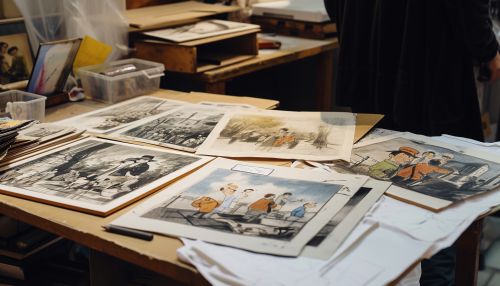Cel Animation
Introduction
Cel animation, also known as traditional animation or classical animation, is a form of animation that involves the use of hand-drawn or painted frames. Each frame, or cel, represents a single moment in time and when these cels are displayed in rapid succession, they create the illusion of movement.
History
The history of cel animation dates back to the early 20th century. The first commercial use of cel animation was in 1914 by cartoonist Winsor McCay, who used this technique for his film "Gertie the Dinosaur". This marked the beginning of the era of traditional animation, a period that would last until the advent of computer animation in the late 20th century.


Process
The process of cel animation is labor-intensive and requires a high level of artistic skill. It begins with the creation of a storyboard, which outlines the narrative of the animation. The storyboard is then used to create an animatic, a rough version of the animation that allows the animators to plan out the timing and composition of each scene.
Once the animatic is complete, the animators begin the process of creating the individual cels. Each cel is hand-drawn or painted onto a transparent sheet, with each frame representing a single moment in time. These cels are then photographed or scanned and compiled into a filmstrip, creating the illusion of movement when displayed in rapid succession.
Techniques
There are several techniques used in cel animation, including:
- Onion Skinning: This technique involves the use of semi-transparent paper to trace over previous drawings, allowing the animator to create smooth, flowing movements.
- Rotoscoping: This technique involves tracing over live-action footage frame by frame, resulting in a highly realistic style of animation.
- Multiplane Camera: This technique involves the use of multiple layers of cels, each on a different plane, to create a sense of depth and perspective.
Advantages and Disadvantages
Cel animation has several advantages over other forms of animation. It allows for a high level of detail and artistic control, and can be used to create a wide range of styles and aesthetics. Additionally, because each frame is hand-drawn, cel animation has a unique, organic quality that is difficult to replicate with computer animation.
However, cel animation also has several disadvantages. It is a time-consuming and labor-intensive process, and requires a high level of artistic skill. Additionally, because each frame is hand-drawn, inconsistencies in the artwork can lead to a lack of smoothness in the animation.
Legacy
Despite the advent of computer animation, cel animation continues to be used in a variety of contexts. Many contemporary animators and studios continue to use traditional animation techniques, either for aesthetic reasons or to pay homage to the history of animation.
